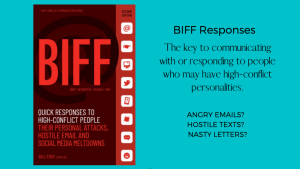A big part of my Firm’s approach to divorce law practice is helping clients navigate communications with a High Conflict Personality (HCP). Many times, the Court will order that the parties limit communication to online monitored platforms like “Our Family Wizard” or “Talking Parents,” but regardless of the platform, difficult, angry, offensive or high conflict narratives can emerge in this messaging from one side. Too often the impulse is to respond in kind, but this kind of like-kind response is almost always counterproductive. Bill Eddy is a longstanding expert in managing High Conflict personalities, and one of his most popular methodologies for managing communications with a HCP is the following:
KEY POINTS
- Brief: It helps to keep it to one paragraph, three to five sentences.
- Informative: Try to just provide straight information, without defensiveness, arguments, emotions, or justifications.
- Friendly: Start with a friendly greeting to set a positive tone.
- Firm: Have your BIFF Response bring an end to a hostile written correspondence.
When you receive a hostile or misinformed email, text, letter, or any other writing, it’s tempting to write back in an equally hostile or disrespectful manner. But instead using what we’ve labeled a “BIFF Response”—short for Brief, Informative, Friendly, and Firm—gives you a simple and structured way to provide useful information without triggering an escalated back-and-forth as we see so much today.

Brief
Even if you are responding to a long email or letter, you can usually respond with just one paragraph of 3-5 sentences. When you have received a long list of hostile points or arguments, you usually don’t need to respond to each one, even though it may feel that way. By being brief, you reduce the risk of triggering more hostility back or including some point that the other person will feel compelled to argue with. If the other person is misinformed, you don’t need to point out that they are misinformed, even though it’s tempting. Instead, briefly provide accurate information.
Informative
The main point of your response should be to provide useful information. Just focus on what the person needs to know, rather than being defensive, emotional, argumentative, or justifying. You don’t need to point out where they got it wrong. Your true information is the best way to clear things up. This often just takes a sentence or two.
Friendly
While this may be the last thing you feel like doing, try to make it friendly. Emotions can be contagious, so try to start your response with a friendly greeting, such as “Thanks for letting me know your concerns.” This often helps a lot in terms of calming someone who has written to you in anger. Otherwise, you’re unnecessarily returning their emotions. You can override another person’s hostility by training yourself to write in a friendly manner. It’s better to have them mirror your positive emotions, rather than you mirroring their negative emotions.
Firm
Firm means that your response should end the hostilities without leaving a hook for the other person to keep responding. “Firm” doesn’t mean “harsh.” Ideally, there is nothing further to be said by either person. However, in some cases, you will need an answer to a question. In that case, try to make it a yes or no question, with a requested response date and time, such as “Please let me know yes or no by Thursday at 5 pm.”
 Illinois Divorce Lawyer Blog
Illinois Divorce Lawyer Blog

